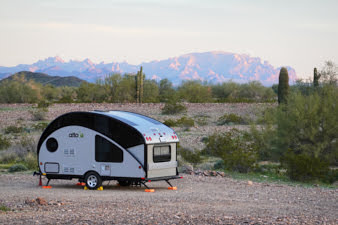We were camped at Sharbot Lake a couple of summers ago, and across from us was a nicely renovated Boler trailer. They had done a great job on it and it looked very cool. We were chatting with them one evening, and I noticed a glow coming from beneath the trailer. They had installed a short strip of blue LED tape near the doorway, and in the dark it provided a sutble lighting effect. This idea stuck in my head, and percolated to the surface this past winter.
We rarely turn on our outside light, as we find it way too bright, even after changing to an amber lense and an LED bulb. It is easy enough to turn on if needed, but I got to thinking about having something to cast a little glow near the step instead. At our local auto parts store, I happened upon a bunch of small LED grommet lights, about 1 inch round, in a variety of colours. A handful of them made the drive home with me.
I initially thought of drilling and insetting one or two of them into the underside of the Alto, but decided to go with a less invasive approach. I made some mounting blocks using the composite moulding material I used for the awning pole holders. Using a mounting block also allowed me to integrate a switch into the unit. A hole was drilled for the light, a smaller hole at a right angle intersected the main hole for the wiring, then a hole on the side to insert the switch. Some 3M mounting tape fastens the blocks in place. I went with the amber lenses, and made up two units, one with a switch that controls both lights. They have an extremely small 0.02 amp/hr draw, so they will not be a power consumption concern. I tapped power for them from the 12v television outlet that is tucked by the door side roof screw jack. The wire and protective wrap, exits the floor between the wheel shroud and the frame.
As always, be very careful when contemplating any sort of drilling within the Alto. Do your homework and think it out very well...then think it out again!
In use, the switch is easily within reach by the step, and they cast just the subtle glow I was hoping to achieve. What first appears to be a simple mod, the effort is always compounded when working in the smaller confines of the Alto. Sometimes it is the price you have to pay!
We rarely turn on our outside light, as we find it way too bright, even after changing to an amber lense and an LED bulb. It is easy enough to turn on if needed, but I got to thinking about having something to cast a little glow near the step instead. At our local auto parts store, I happened upon a bunch of small LED grommet lights, about 1 inch round, in a variety of colours. A handful of them made the drive home with me.
I initially thought of drilling and insetting one or two of them into the underside of the Alto, but decided to go with a less invasive approach. I made some mounting blocks using the composite moulding material I used for the awning pole holders. Using a mounting block also allowed me to integrate a switch into the unit. A hole was drilled for the light, a smaller hole at a right angle intersected the main hole for the wiring, then a hole on the side to insert the switch. Some 3M mounting tape fastens the blocks in place. I went with the amber lenses, and made up two units, one with a switch that controls both lights. They have an extremely small 0.02 amp/hr draw, so they will not be a power consumption concern. I tapped power for them from the 12v television outlet that is tucked by the door side roof screw jack. The wire and protective wrap, exits the floor between the wheel shroud and the frame.
As always, be very careful when contemplating any sort of drilling within the Alto. Do your homework and think it out very well...then think it out again!
 |
| the buddy light on the front side of the step |
 |
| had to re-position and modify the spray shield for the remote temp sensor |
In use, the switch is easily within reach by the step, and they cast just the subtle glow I was hoping to achieve. What first appears to be a simple mod, the effort is always compounded when working in the smaller confines of the Alto. Sometimes it is the price you have to pay!












































